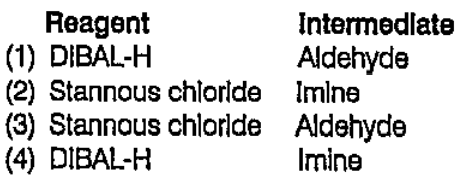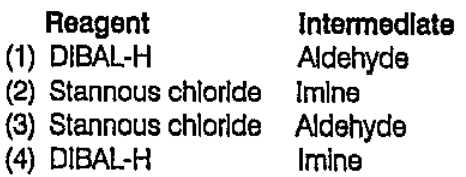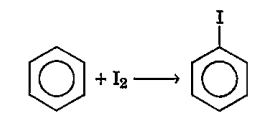Select the reagent used and the intermediate formed in Stephen reaction.




The correct Answer is:B
Step-by-Step Solution:
1. Understanding the Stephen Reaction:
The Stephen reaction involves the reduction of alkyl cyanides to aldehydes. This reaction is significant in organic synthesis.
2. Identifying the Reagents:
The key reagent used in the Stephen reaction is stannous chloride (SnCl2), which acts as a reducing agent in the presence of aqueous hydrochloric acid (HCl). The aqueous HCl is necessary for the hydrolysis step that follows the reduction.
3. Mechanism of the Reaction:
- The reaction begins with the alkyl cyanide (R-C≡N) being reduced by stannous chloride in the presence of hydrochloric acid.
- The first step of the reaction results in the formation of an intermediate, which is an imine salt. The structure of this intermediate can be represented as R-C(=NH)-Cl.
4. Hydrolysis Step:
- After the formation of the imine salt, hydrolysis occurs, where water reacts with the imine salt to convert it into an aldehyde.
- The final product of the Stephen reaction is an aldehyde (R-CHO).
5. Conclusion:
- The reagent used in the Stephen reaction is stannous chloride (SnCl2).
- The intermediate formed during the reaction is an imine salt.
Final Answer:
- Reagent used: Stannous chloride (SnCl2)
- Intermediate formed: Imine salt
---
The Stephen reaction involves the reduction of alkyl cyanides to aldehydes. This reaction is significant in organic synthesis.
The key reagent used in the Stephen reaction is stannous chloride (SnCl2), which acts as a reducing agent in the presence of aqueous hydrochloric acid (HCl). The aqueous HCl is necessary for the hydrolysis step that follows the reduction.
- The reaction begins with the alkyl cyanide (R-C≡N) being reduced by stannous chloride in the presence of hydrochloric acid.
- The first step of the reaction results in the formation of an intermediate, which is an imine salt. The structure of this intermediate can be represented as R-C(=NH)-Cl.
- After the formation of the imine salt, hydrolysis occurs, where water reacts with the imine salt to convert it into an aldehyde.
- The final product of the Stephen reaction is an aldehyde (R-CHO).
- The reagent used in the Stephen reaction is stannous chloride (SnCl2).
- The intermediate formed during the reaction is an imine salt.
- Reagent used: Stannous chloride (SnCl2)
- Intermediate formed: Imine salt
Similar Questions
Knowledge Check
- Question 1 - Select One
Intermediate formed during E2 reaction is -
ACarbocationBCarbanionCFree radicalDIntermediate is not Formed - Question 2 - Select One
Intermediate formed during E1 reaction is -
ACarbocationBCarbanionCFree radicalDCarbene - Question 3 - Select One
Select the reagent used in the rosenmund reaction.
AH2BPd−baSO4Cboth (1) and both 2Dnone of these

The intermediate species formed in the above reaction is:View SolutionName the reagent used in this reaction.
 View Solution
View SolutionThe structure of the intermediate formed in the Riemer Tiemann reaction is :
View SolutionToluene on reaction with CrO3 and Ac2O gives benzaldehyde as the main product. The intermediate compound formed in the reaction is:
View SolutionSelect the reagent for the following reaction
 View Solution
View Solution

